Abstract
The cytokinetics of the antibody to Type III pneumococcal polysaccharide (SSS-III) were characterized by an immuno-plaque procedure using erythrocytes sensitized with SSS-III. Prior immunization, irrespective of the doses employed, did not result in the development of immunological memory; instead, low-dose paralysis was produced in mice previously immunized with all doses of SSS-III.
Dose-response studies revealed that within a given dose range, there was a direct relationship between the immunizing dose and the magnitude of the antibody response obtained. The dose-response curve for SSS-III showed a single optimal dose for immunization; doses only slightly in excess of the optimal dose produced a significant reduction in the magnitude of the antibody response. The implications of these findings, with respect to the development of paralysis to SSS-III, are discussed.
Full text
PDF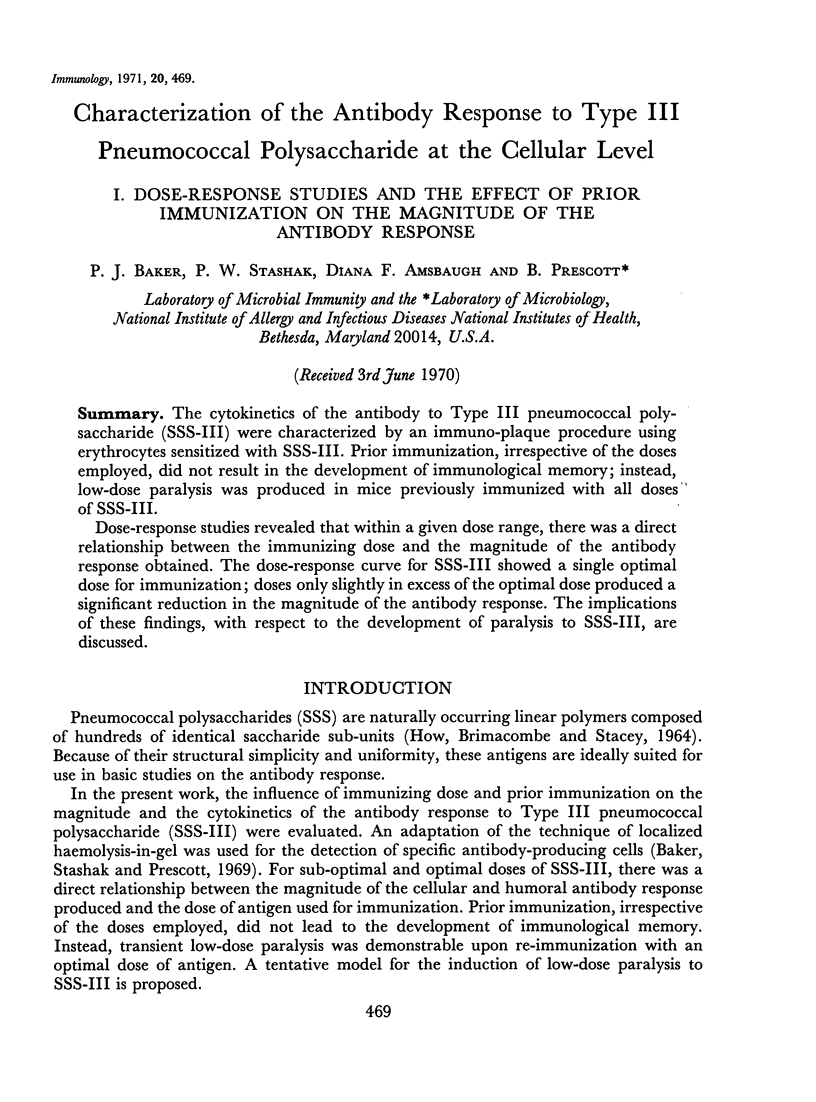
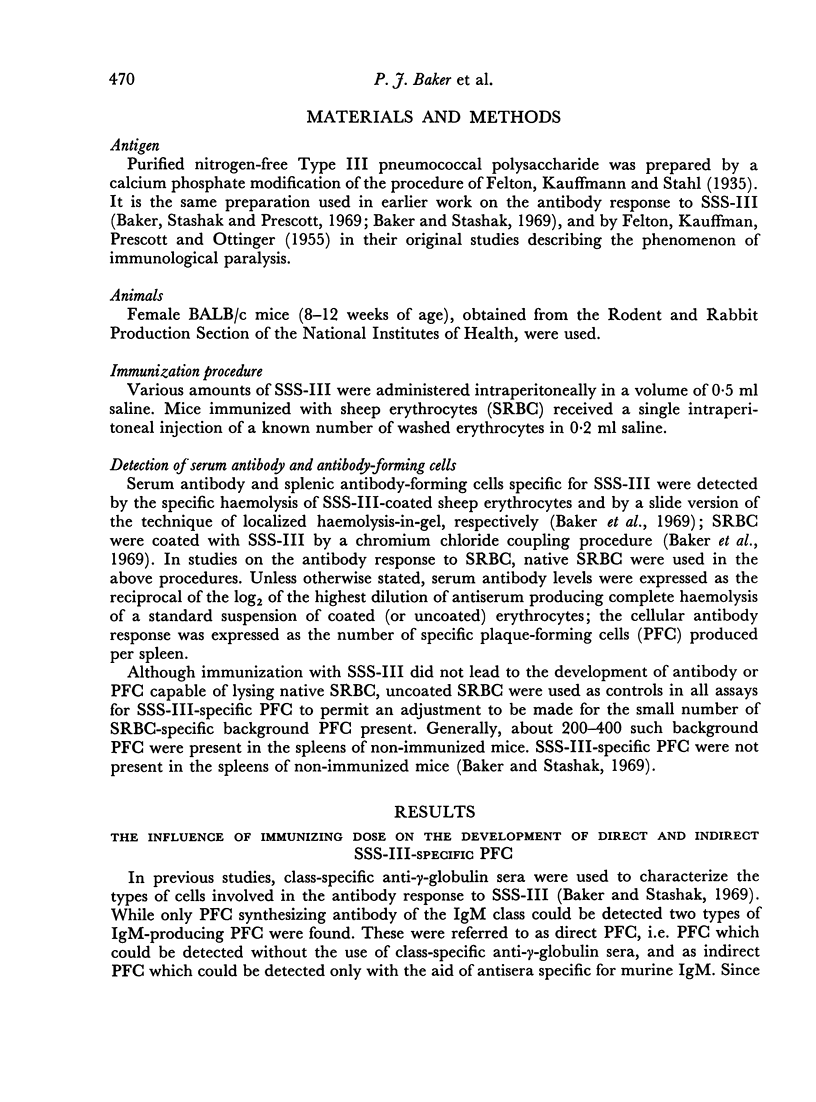
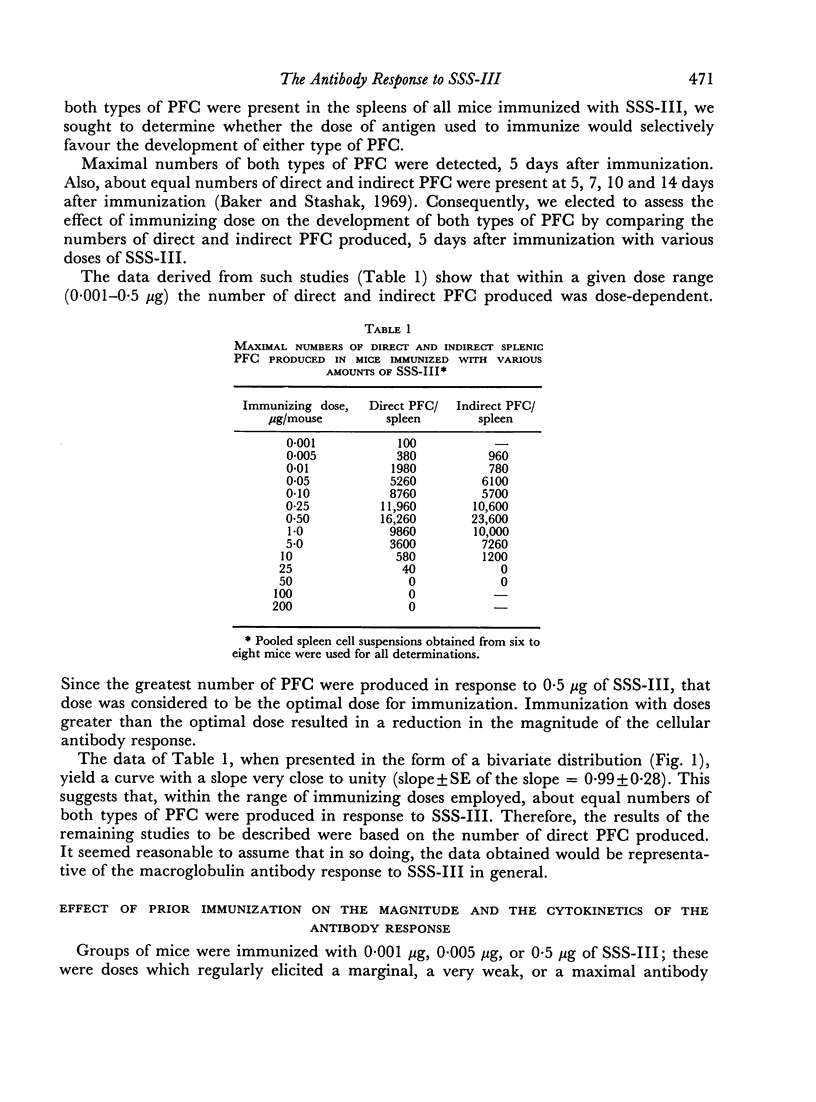
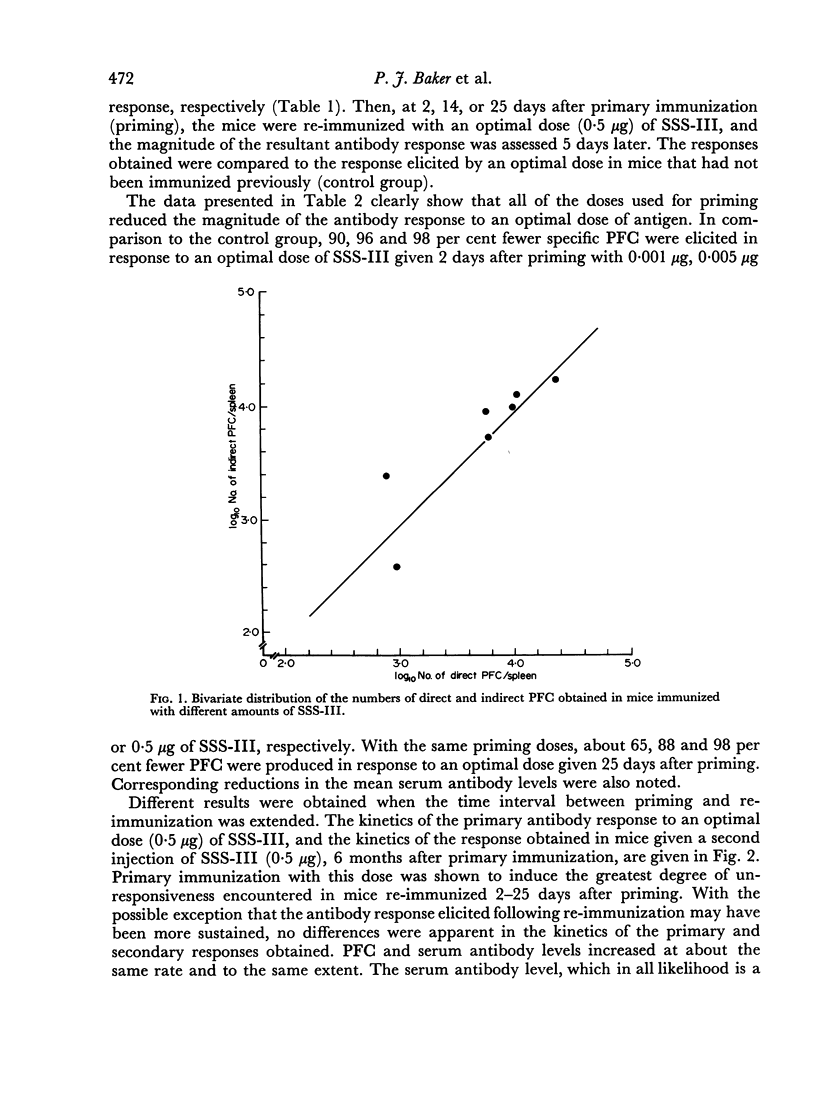
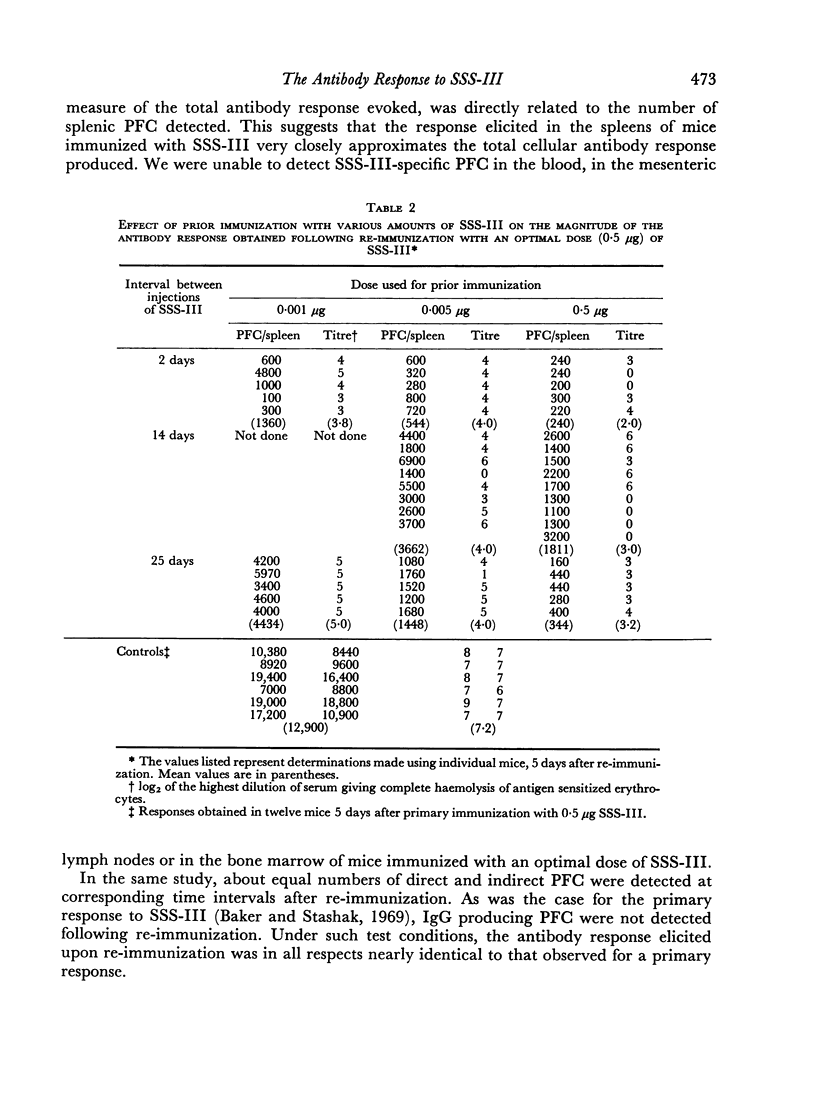
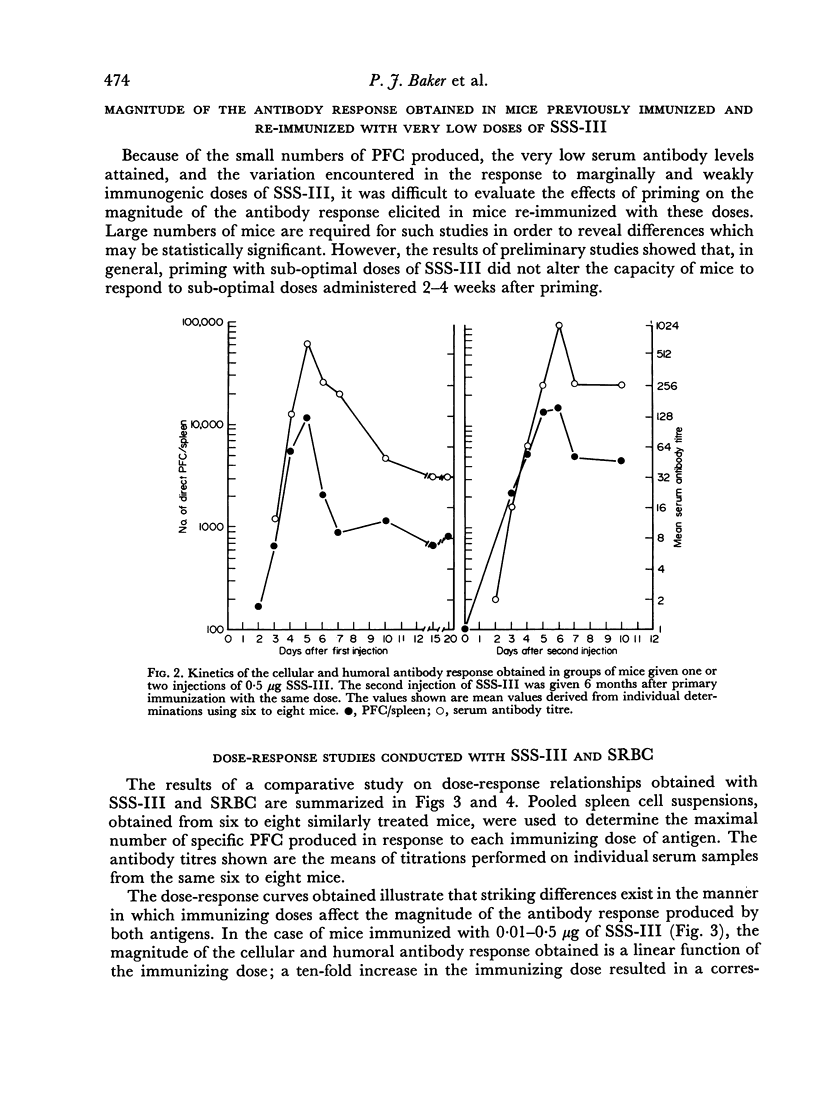
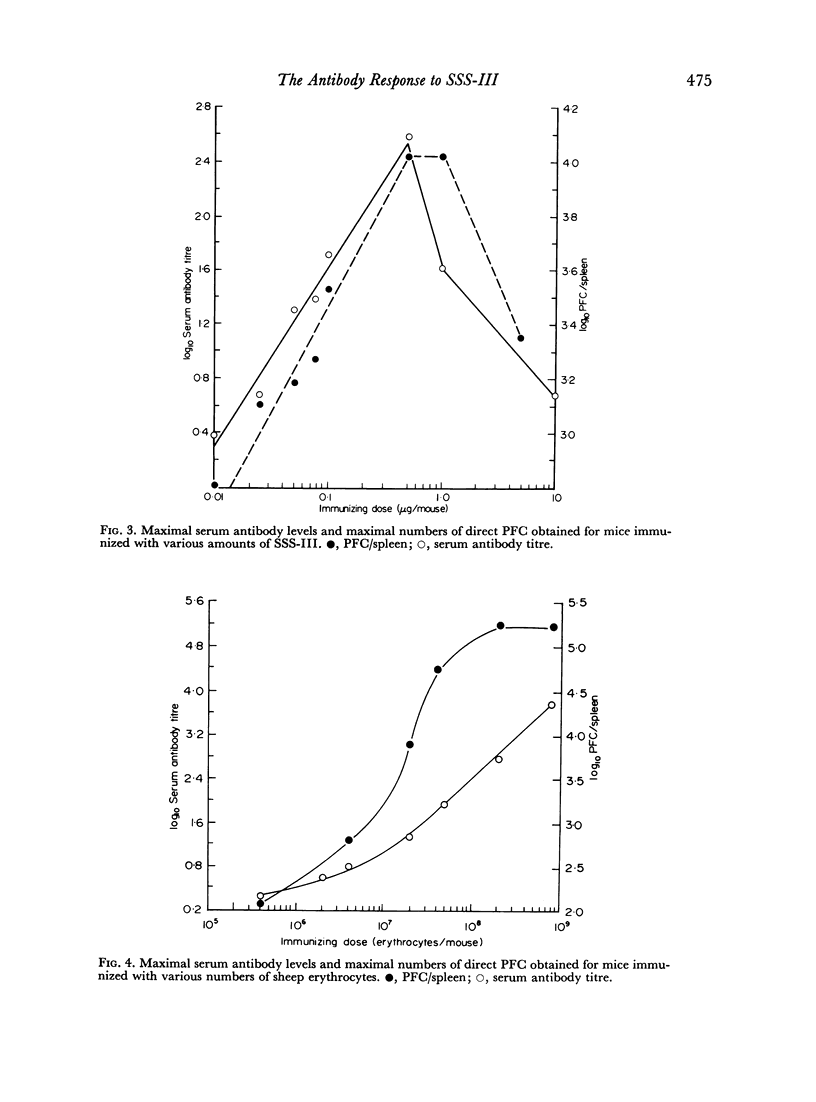
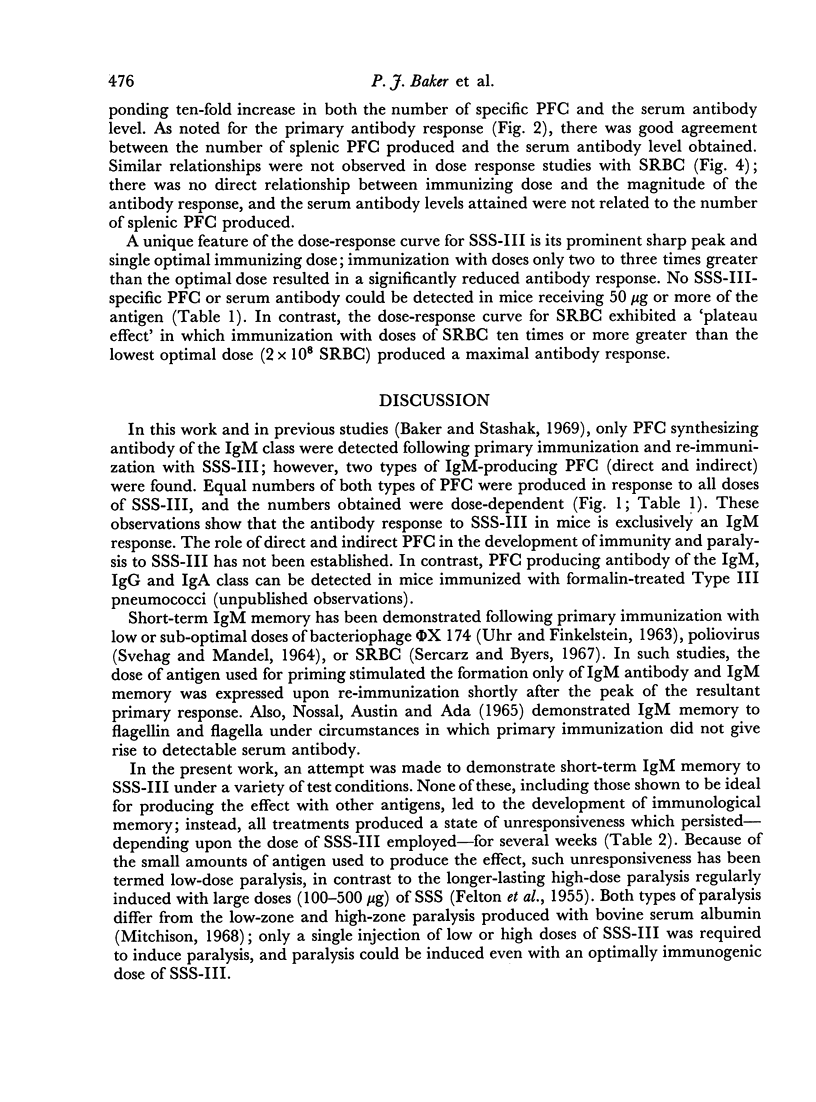
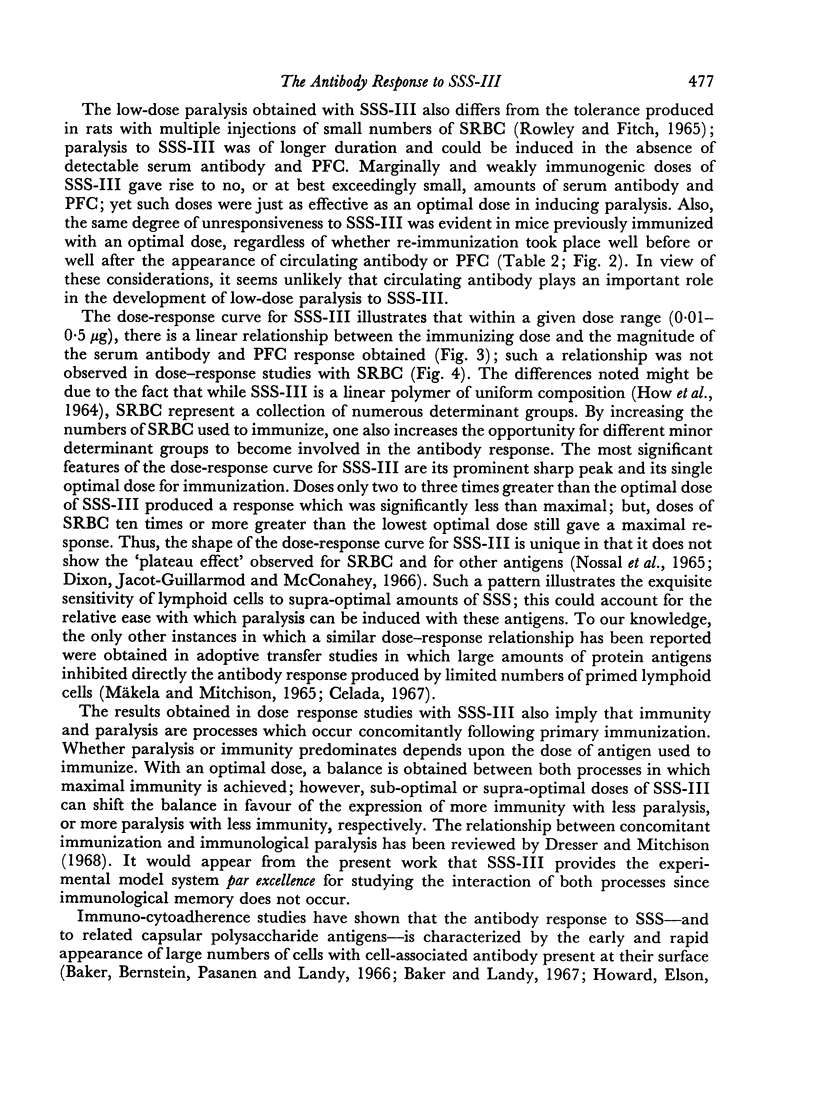
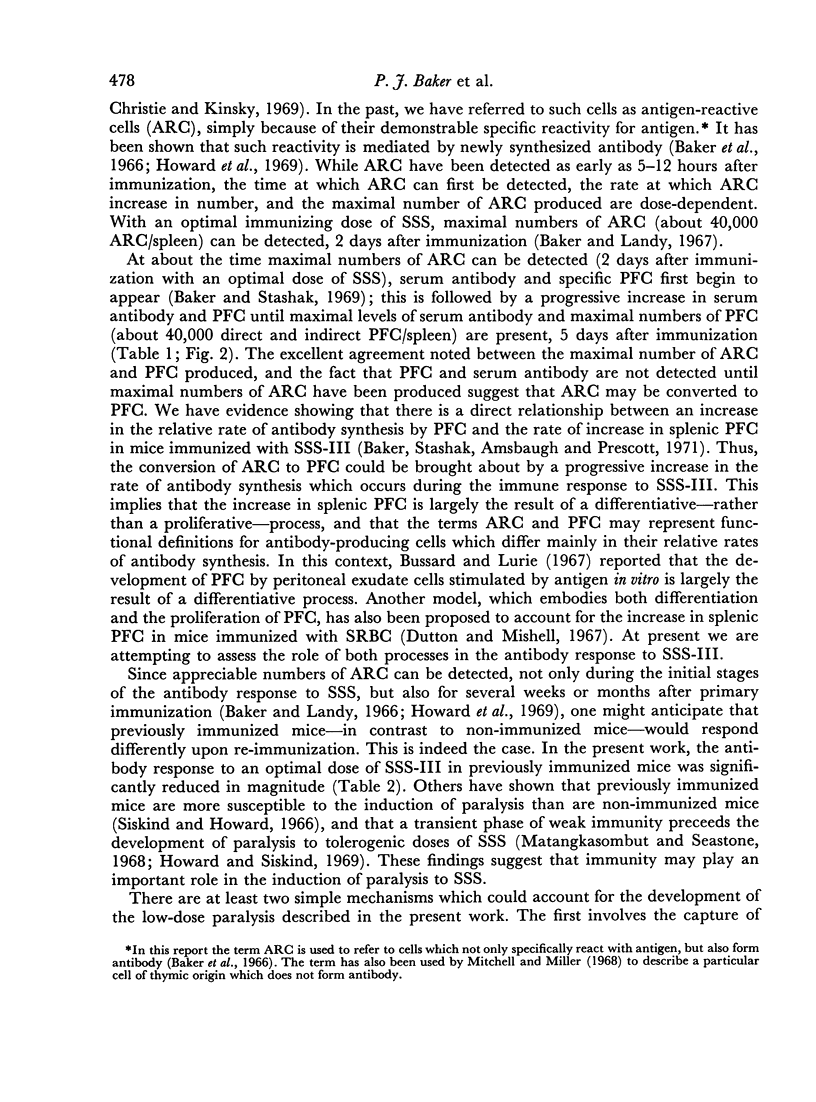
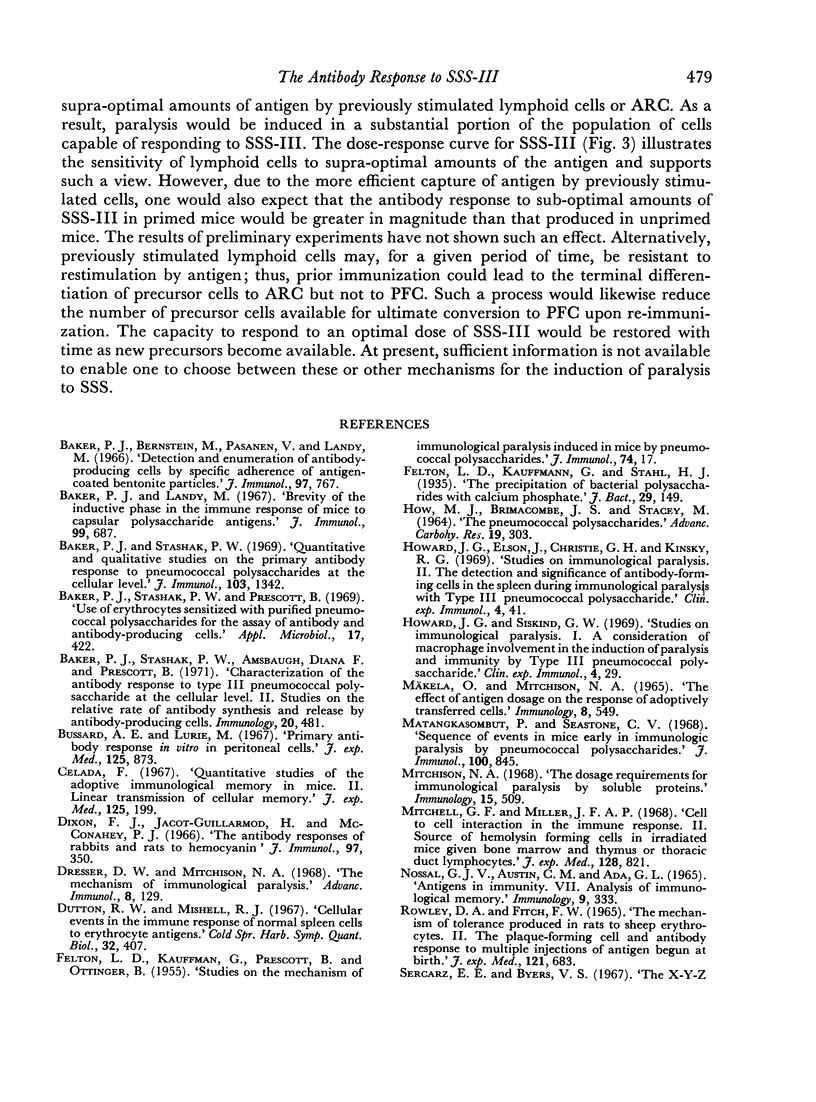
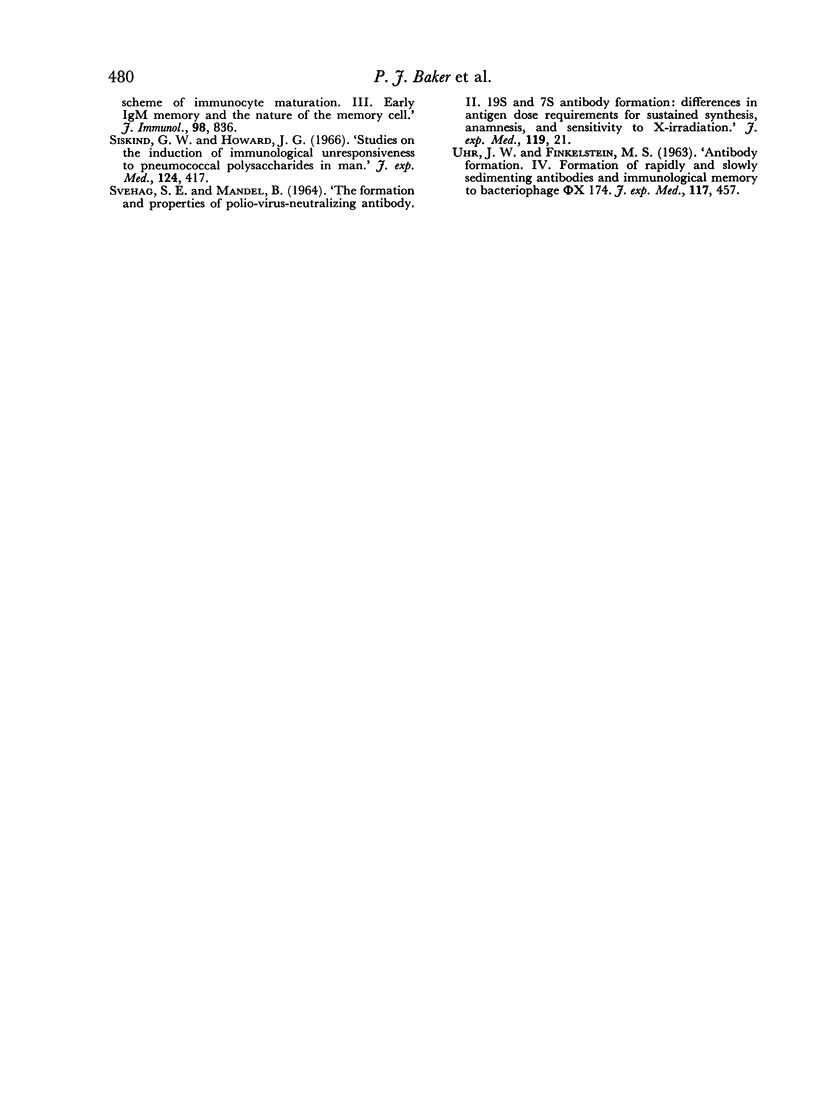
Selected References
These references are in PubMed. This may not be the complete list of references from this article.
- Baker P. H., Stashak P. W. Quantitative and qualitative studies on the primary antibody response to pneumococcal polysaccharides at ehe cellular level. J Immunol. 1969 Dec;103(6):1342–1348. [PubMed] [Google Scholar]
- Baker P. J., Bernstein M., Pasanen V., Landy M. Detection and enumeration of antibody-producing cells by specific adherence of antigen-coated bentonite particles. J Immunol. 1966 Dec;97(6):767–777. [PubMed] [Google Scholar]
- Baker P. J., Landy M. Brevity of the inductive phase in the immune response of mice to capsular polysaccharide antigens. J Immunol. 1967 Oct;99(4):687–694. [PubMed] [Google Scholar]
- Baker P. J., Stashak P. W., Amsbaugh D. F., Prescott B. Characterization of the antibody response to type 3 pneumococcal polysaccharide at the cellular level. II. Studies on the relative rate of antibody synthesis and release by antibody-producing cells. Immunology. 1971 Apr;20(4):481–492. [PMC free article] [PubMed] [Google Scholar]
- Baker P. J., Stashak P. W., Prescott B. Use of erythrocytes sensitized with purified pneumococcal polysaccharides for the assay of antibody and antibody-producing cells. Appl Microbiol. 1969 Mar;17(3):422–426. doi: 10.1128/am.17.3.422-426.1969. [DOI] [PMC free article] [PubMed] [Google Scholar]
- Bussard A. E., Lurie M. Primary antibody response in vitro in peritoneal cells. J Exp Med. 1967 May 1;125(5):873–892. doi: 10.1084/jem.125.5.873. [DOI] [PMC free article] [PubMed] [Google Scholar]
- Celada F. Quantitative studies of the adoptive immunological memory in mice. II. Linear transmission of cellular memory. J Exp Med. 1967 Feb 1;125(2):199–211. doi: 10.1084/jem.125.2.199. [DOI] [PMC free article] [PubMed] [Google Scholar]
- Dresser D. W., Mitchison N. A. The mechanism of immunological paralysis. Adv Immunol. 1968;8:129–181. doi: 10.1016/s0065-2776(08)60466-6. [DOI] [PubMed] [Google Scholar]
- FELTON L. D., KAUFFMANN G., PRESCOTT B., OTTINGER B. Studies on the mechanism of the immunological paralysis induced in mice by pneumococcal polysaccharides. J Immunol. 1955 Jan;74(1):17–26. [PubMed] [Google Scholar]
- Felton L. D., Kauffmann G., Stahl H. J. The Precipitation of Bacterial Polysaccharides with Calcium Phosphate : Pneumococcus. J Bacteriol. 1935 Feb;29(2):149–161. doi: 10.1128/jb.29.2.149-161.1935. [DOI] [PMC free article] [PubMed] [Google Scholar]
- HOW M. J., BRIMACOMBE J. S., STACEY M. THE PNEUMOCOCCAL POLYSACCHARIDES. Adv Carbohydr Chem. 1964;19:303–358. doi: 10.1016/s0096-5332(08)60285-4. [DOI] [PubMed] [Google Scholar]
- Howard J. G., Elson J., Christie G. H., Kinsky R. G. Studies on immunological paralysis. II. The detection and significance of antibod-forming cells in the spleen during immunological paralysis with type 3 pneumococcal polysaccharide. Clin Exp Immunol. 1969 Jan;4(1):41–53. [PMC free article] [PubMed] [Google Scholar]
- Howard J. G., Siskind G. W. Studies on immunological paralysis. I. A consideration of macrophage involvement in the induction of paralysis and immunity by type II pneumococcal polysaccharide. Clin Exp Immunol. 1969 Jan;4(1):29–39. [PMC free article] [PubMed] [Google Scholar]
- Matangkasombut P., Seastone C. V. Sequence of events in mice early in immunologic paralysis by pneumococcal polysaccharide. J Immunol. 1968 Apr;100(4):845–850. [PubMed] [Google Scholar]
- Mitchell G. F., Miller J. F. Cell to cell interaction in the immune response. II. The source of hemolysin-forming cells in irradiated mice given bone marrow and thymus or thoracic duct lymphocytes. J Exp Med. 1968 Oct 1;128(4):821–837. doi: 10.1084/jem.128.4.821. [DOI] [PMC free article] [PubMed] [Google Scholar]
- Mitchison N. A. The dosage requirements for immunological paralysis by soluble proteins. Immunology. 1968 Oct;15(4):509–530. [PMC free article] [PubMed] [Google Scholar]
- Mäkelä O., Mitchison N. A. The effect of antigen dosage on the response of adoptively transferred cells. Immunology. 1965 Jun;8(6):549–556. [PMC free article] [PubMed] [Google Scholar]
- Nossal G. J., Austin C. M., Ada G. L. Antigens in immunity. VII. Analysis of immunological memory. Immunology. 1965 Oct;9(4):333–348. [PMC free article] [PubMed] [Google Scholar]
- ROWLEY D. A., FITCH F. W. THE MECHANISM OF TOLERANCE PRODUCED IN RATS TO SHEEP ERYTHROCYTES. II. THE PLAQUE-FORMING CELL AND ANTIBODY RESPONSE TO MULTIPLE INJECTIONS OF ANTIGEN BEGUN AT BIRTH. J Exp Med. 1965 May 1;121:683–695. doi: 10.1084/jem.121.5.683. [DOI] [PMC free article] [PubMed] [Google Scholar]
- SVEHAG S. E., MANDEL B. THE FORMATION AND PROPERTIES OF POLIOVIRUS-NEUTRALIZING ANTIBODY. II. 19S AND 7S ANTIBODY FORMATION: DIFFERENCES IN ANTIGEN DOSE REQUIREMENT FOR SUSTAINED SYNTHESIS, ANAMNESIS, AND SENSITIVITY TO X-IRRADIATION. J Exp Med. 1964 Jan 1;119:21–39. doi: 10.1084/jem.119.1.21. [DOI] [PMC free article] [PubMed] [Google Scholar]
- Sercarz E. E., Byers V. S. The X-Y-Z scheme of immunocyte maturation. 3. Early IgM memory and the nature of the memory cell. J Immunol. 1967 Apr;98(4):836–843. [PubMed] [Google Scholar]
- Siskind G. W., Howard J. G. Studies on the induction of immunological unresponsiveness to pneumococcal polysaccharide in mice. J Exp Med. 1966 Sep 1;124(3):417–429. doi: 10.1084/jem.124.3.417. [DOI] [PMC free article] [PubMed] [Google Scholar]
- UHR J. W., FINKELSTEIN M. S. Antibody formation. IV. Formation of rapidly and slowly sedimenting antibodies and immunological memory to bacteriophage phi-X 174. J Exp Med. 1963 Mar 1;117:457–477. doi: 10.1084/jem.117.3.457. [DOI] [PMC free article] [PubMed] [Google Scholar]


